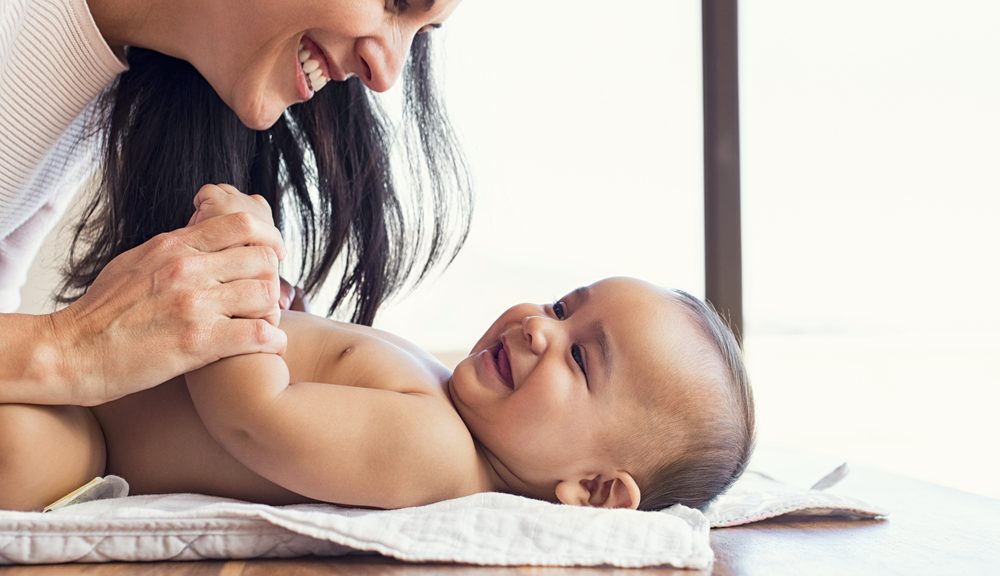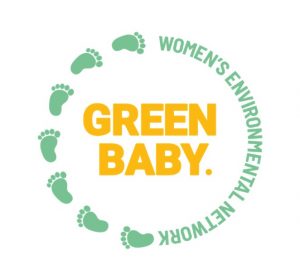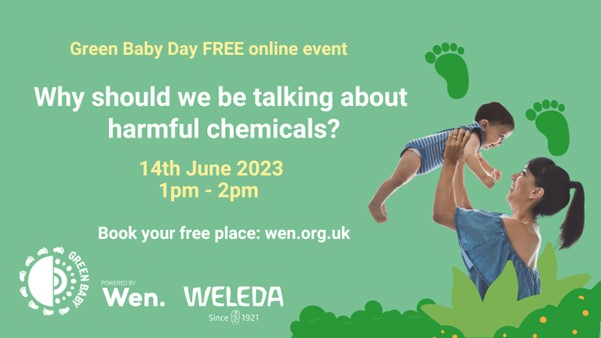
Introducing Green Baby Day
 The Women’s Environmental Network (Wen) is launching the first ever Green Baby Day on 14 June, sponsored by Weleda. The day of action calls for a sustainable and toxic-free future for babies and children, their parents and carers.
The Women’s Environmental Network (Wen) is launching the first ever Green Baby Day on 14 June, sponsored by Weleda. The day of action calls for a sustainable and toxic-free future for babies and children, their parents and carers.
Green Baby Day aims to provide information to help families make healthy, eco-friendly and affordable choices to minimise exposure to harmful chemicals, and focuses attention on the need to ensure effective chemicals regulation to protect current and future generations, especially post-Brexit1.
Join the free online discussion ‘Why should we be talking about harmful chemicals?’ on 14 June from 1-2pm with guest speakers Charlotte Brody, National Director for Healthy Babies Bright Futures and Vice President for Health Initiatives of the BlueGreen Alliance, together with Wen’s expert scientific researcher Helen Lynn, and Weleda’s Skincare Expert Elizabeth King, to find out why we should be concerned about toxic chemicals in everyday products and what we can do to reduce our exposure.
Why Green Baby?
Exposure to toxic chemicals and pesticides is a feature of everyday lives in our homes, workplaces and in the wider environment. There are tens of thousands of chemicals in regular commercial use, many with little health and safety information, with the potential to harm our health, our fertility, the health of our children and future generations2.
Chemicals and even microplastics from consumer products have a nasty habit of ending up where they shouldn’t. Recent examples include microplastic in baby poo3 and 109 toxic chemicals such as flame retardants, cosmetics ingredients, and plasticisers found in maternal and umbilical cord blood, including 55 that had never been found in people before4.
Linda Tai, Wen’s Green Baby campaign manager, called for safer chemicals regulation so that “parents and carers can exercise their right to a healthy environment to bring up their children. The children of tomorrow have the right to a clean and sustainable environment to grow and develop”.
Green Baby Tips
Weleda shares some top tips on what to look for when purchasing toiletries for babies and children:
- Choose multi-tasking products like Weleda’s Calendula All Purpose Balm or Calendula Shampoo & Bodywash, so you are buying less, and exposing your newborn’s skin to fewer ingredients.
- Young babies don’t need a daily bath or hair wash. A simple top-and-tail wash will keep your newborn clean, saving water, and saving you money.
- Avoid harsh or synthetic detergents (eg SLS or SLES) which may strip skin of its natural protective oils, leading to dryness and greater sensitivity and even eczema.
- Don’t use adult toiletries on your baby as they may include ingredients which are not suitable for baby skincare, such as the synthetic preservative MI and which is a known irritant.
- Look for a certification logo (such as NATRUE) on babycare to confirm products are genuinely natural or organic, for quality and purity and to avoid endocrine disrupting chemicals such as parabens or triclosan.
- Choose a nappy cream made with plant oils instead of mineral oils (petrolatum) as mineral oils/fossil fuels are not sustainable, nor are they ideal for cloth nappies as they can clog the fibres.
- Opt for baby skincare products that have packaging that you can recycle at home. Ideally packaging that is also made with recycled materials such as Weleda’s baby bottles.
For more information about Green Baby Day, visit: www.wen.org.uk/greenbabyday
References
1 12 Key Priority Asks https://allianceforcancerprevention.org.uk/2021/05/11/12-key-priority-asks-for-the-uks-new-chemicals-strategy/
2 Skinner, M. Endocrine disruptor induction of epigenetic transgenerational inheritance of disease. Molecular and Cellular Endocrinology 398 (2014) 4–12
3 Zhang, J et al. Occurrence of Polyethylene Terephthalate and Polycarbonate Microplastics in Infant and Adult Feces. Environmental Science & Technology Letters 2021 8 (11), 989-994.
4 Wang, A et al. Suspect Screening, Prioritization, and Confirmation of Environmental Chemicals in Maternal-Newborn Pairs from San Francisco. Environmental Science & Technology 2021 55 (8), 5037-5049.
